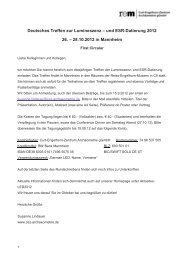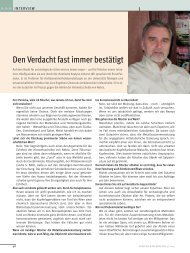Jahresbericht 2010 - Curt-Engelhorn-Zentrum Archäometrie gGmbH
Jahresbericht 2010 - Curt-Engelhorn-Zentrum Archäometrie gGmbH
Jahresbericht 2010 - Curt-Engelhorn-Zentrum Archäometrie gGmbH
Sie wollen auch ein ePaper? Erhöhen Sie die Reichweite Ihrer Titel.
YUMPU macht aus Druck-PDFs automatisch weboptimierte ePaper, die Google liebt.
Seite 42 <strong>Jahresbericht</strong> <strong>2010</strong><br />
25000<br />
20000<br />
15000<br />
10000<br />
5000<br />
0<br />
1 2 3 4 5<br />
Fig. 3 Weight share of basic<br />
petrographic groups in the<br />
lithic inventory of Kopačina:<br />
1 total weight of analysed<br />
items, 2 radiolarites, 3 metasomatic<br />
cherts, 4 petrographically<br />
unidentifiable, 5<br />
-fired cherts. (graph)<br />
thumbnail endscraper<br />
circular endscraper<br />
endscraper on flake<br />
endscraper on…<br />
backed bladelet<br />
arched backed point<br />
microgravette<br />
gravettian point<br />
segment<br />
rectangular<br />
truncation<br />
sidescraper<br />
borer<br />
burin<br />
splintered piece<br />
marginally retouched piece<br />
retouched piece<br />
denticulate<br />
notch<br />
retouched fragment<br />
of petrographic samples,<br />
geological bibliographic<br />
resources and information<br />
of our fellow geologists<br />
and archaeologists on<br />
sources of the rocks in<br />
question (Geological samples,<br />
database of macro-<br />
and microscopic findings<br />
as well as microscopic<br />
photographs are from the<br />
Geoarchaeological<br />
Lithoteque, Perhoc <strong>2010</strong>).<br />
Based on the listed criteria,<br />
the following material<br />
groups of archaeological<br />
findings were identified:<br />
radiolarites, metasomatic<br />
cherts and the group of<br />
petrographically unidentifiable<br />
cherts (Figure 3).<br />
In the technological part of<br />
the lithic analysis, the total<br />
of 17 categories was defined<br />
(nodule, primary<br />
0% 5% 10% 15% 20% 25%<br />
Fig. 4 Figure 4. Relative<br />
frequency of tool types in<br />
lithic phase I and lithic phase<br />
II. (graph)<br />
% %<br />
flake, primary blade, primary<br />
bladelet, secondary<br />
flake, secondary blade, secondary<br />
bladelet, flake,<br />
blade, bladelet, core, core<br />
fragment, crested piece,<br />
core rejuvenation flake,<br />
burin spall, chunk and unidentifiable),<br />
which may<br />
represent different reduction<br />
phases. The technological<br />
analysis yielded a fairly<br />
homogenous picture in the<br />
entire stratigraphic sequence.<br />
Individual types of tools<br />
were predominantly de-<br />
fined according to the Upper<br />
Palaeolithic typology by<br />
P.-Y. Demars and P. Laurent<br />
(thumbnail endscrapers,<br />
arched backed points,<br />
backed bladelets, Gravettian<br />
points, geometric microliths,<br />
sidescrapers, splintered<br />
pieces, borers, burins,<br />
truncations), while certain<br />
types such as, for example,<br />
marginally retouched pieces,<br />
circular endscraper,<br />
endscraper on flake, endscraper<br />
on blade/bladelet<br />
and microgravette were<br />
added.<br />
Based on the relative frequency<br />
of backed bladelets<br />
and arched backed points,<br />
which are very clearly typologically<br />
identifiable, two<br />
lithic phases were separated<br />
(Figure 4). Younger<br />
phase (lithic phase II) includes<br />
depths from 0-140,<br />
and older (lithic phase I)<br />
from 140-300 cm. The objective<br />
of technological and<br />
typological analysis was to<br />
determine the likely existence<br />
of diachronic changes<br />
in the manufacture of stone<br />
artefacts.<br />
Regional context of the<br />
Late Glacial industries of<br />
eastern Adriatic and hinterland<br />
Ön the basis of regional<br />
comparison, in addition to<br />
all similarities and differences,<br />
certain chronological<br />
and stratigraphic analogies<br />
of the Kopac ina industry<br />
with the Late Glacial industries<br />
in Istria (S andalja II,<br />
Nugljanska, Ves anska and<br />
Pupic ina caves), in Dalmatia<br />
(Vlakno cave on the island<br />
of Dugi otok, Zemunica<br />
cave in Dalmatinska Zagora<br />
and Vela cave on the island<br />
of Korc ula), in Herzegovina<br />
(abri Badanj near Stolac)<br />
and Montenegro (Crvena<br />
stijena, Malis ina stijena,<br />
Medena stijena and<br />
Trebac ki krs ) were established.<br />
Based on the performed<br />
techno-typological<br />
analysis, it may be concluded<br />
that the Kopac ina industry<br />
exhibits greatest similarity<br />
to Badanj and Vela<br />
cave, which may be associated<br />
with geographic proximity<br />
of these sites.<br />
Conclusion<br />
The petrographic analysis<br />
of lithic artefacts from<br />
Kopac ina cave, although<br />
limited in scope, represents<br />
a foundation for a geoarchaeological<br />
outline of the<br />
economy of lithic raw material<br />
procurement and thus<br />
also the mobility network<br />
of the Kopac ina population<br />
in the Late Glacial environment.<br />
The analysed lithic<br />
artefacts were made from<br />
metasomatic cherts and<br />
radiolarites. Eight material<br />
groups were identified, of<br />
which three were surely<br />
imported to Brac . Those are<br />
the groups of red (Figure 5-<br />
6), green radiolarites<br />
(Figure 7) and nummulites<br />
(Figure 8) with the total<br />
weight share of 12%. These<br />
are indisputable evidence<br />
of the Kopac ina population<br />
movements in the area of<br />
today’s Middle Dalmatia<br />
and regions on the eastern<br />
side of the Adriatic, probably<br />
all the way to Central<br />
Bosnia. These three groups<br />
were represented in all<br />
depths of the excavated<br />
cave sediment (less in<br />
deeper older layers), which<br />
points to the continuity of<br />
the assumed mobility network<br />
of hunter-gatherers<br />
from Kopac ina.<br />
While the nummulite group<br />
testifies about the island’s<br />
connection with the present<br />
day’s coastal belt, the<br />
groups of green and red<br />
radiolarite with a small<br />
share in the lithic assem-




